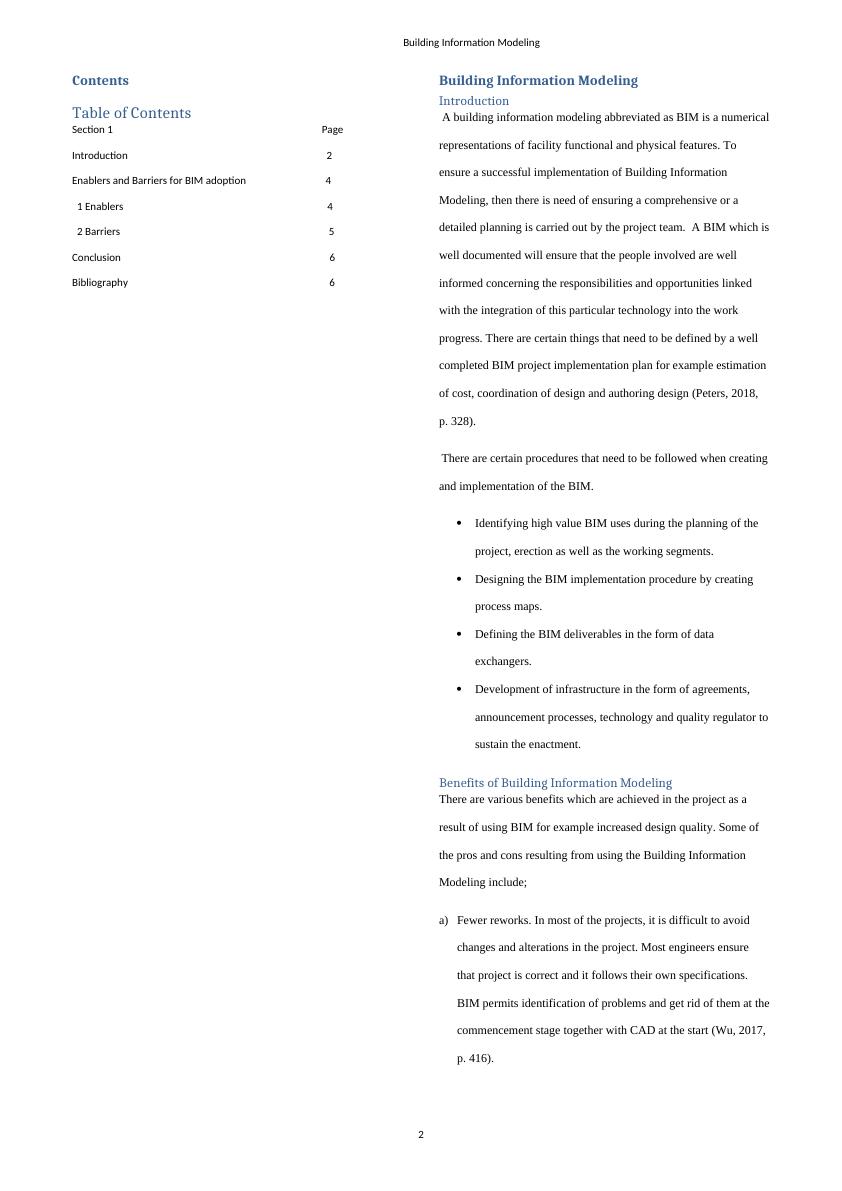Enablers and Barriers for BIM Adoption
Added on 2023-05-30
7 Pages2022 Words148 Views
Building Information Modeling
Research on Enablers and Barriers for BIM adoption
By
Name of the Student
Name of the Professor
City/State
Date/Month/Year
1
Research on Enablers and Barriers for BIM adoption
By
Name of the Student
Name of the Professor
City/State
Date/Month/Year
1

Building Information Modeling
Contents
Table of Contents
Section 1 Page
Introduction 2
Enablers and Barriers for BIM adoption 4
1 Enablers 4
2 Barriers 5
Conclusion 6
Bibliography 6
Building Information Modeling
Introduction
A building information modeling abbreviated as BIM is a numerical
representations of facility functional and physical features. To
ensure a successful implementation of Building Information
Modeling, then there is need of ensuring a comprehensive or a
detailed planning is carried out by the project team. A BIM which is
well documented will ensure that the people involved are well
informed concerning the responsibilities and opportunities linked
with the integration of this particular technology into the work
progress. There are certain things that need to be defined by a well
completed BIM project implementation plan for example estimation
of cost, coordination of design and authoring design (Peters, 2018,
p. 328).
There are certain procedures that need to be followed when creating
and implementation of the BIM.
Identifying high value BIM uses during the planning of the
project, erection as well as the working segments.
Designing the BIM implementation procedure by creating
process maps.
Defining the BIM deliverables in the form of data
exchangers.
Development of infrastructure in the form of agreements,
announcement processes, technology and quality regulator to
sustain the enactment.
Benefits of Building Information Modeling
There are various benefits which are achieved in the project as a
result of using BIM for example increased design quality. Some of
the pros and cons resulting from using the Building Information
Modeling include;
a) Fewer reworks. In most of the projects, it is difficult to avoid
changes and alterations in the project. Most engineers ensure
that project is correct and it follows their own specifications.
BIM permits identification of problems and get rid of them at the
commencement stage together with CAD at the start (Wu, 2017,
p. 416).
2
Contents
Table of Contents
Section 1 Page
Introduction 2
Enablers and Barriers for BIM adoption 4
1 Enablers 4
2 Barriers 5
Conclusion 6
Bibliography 6
Building Information Modeling
Introduction
A building information modeling abbreviated as BIM is a numerical
representations of facility functional and physical features. To
ensure a successful implementation of Building Information
Modeling, then there is need of ensuring a comprehensive or a
detailed planning is carried out by the project team. A BIM which is
well documented will ensure that the people involved are well
informed concerning the responsibilities and opportunities linked
with the integration of this particular technology into the work
progress. There are certain things that need to be defined by a well
completed BIM project implementation plan for example estimation
of cost, coordination of design and authoring design (Peters, 2018,
p. 328).
There are certain procedures that need to be followed when creating
and implementation of the BIM.
Identifying high value BIM uses during the planning of the
project, erection as well as the working segments.
Designing the BIM implementation procedure by creating
process maps.
Defining the BIM deliverables in the form of data
exchangers.
Development of infrastructure in the form of agreements,
announcement processes, technology and quality regulator to
sustain the enactment.
Benefits of Building Information Modeling
There are various benefits which are achieved in the project as a
result of using BIM for example increased design quality. Some of
the pros and cons resulting from using the Building Information
Modeling include;
a) Fewer reworks. In most of the projects, it is difficult to avoid
changes and alterations in the project. Most engineers ensure
that project is correct and it follows their own specifications.
BIM permits identification of problems and get rid of them at the
commencement stage together with CAD at the start (Wu, 2017,
p. 416).
2

Building Information Modeling
b) Collaboration is improved by BIM allocation of task plus cost
estimation can be done easily since BIM allows assigning of
materials and resources to surfaces thus enabling the contractor
to know the resources to order thus cost saving.
Disadvantages
a) Lack of knowledge. Most of the construction industries lack
knowledge concerning the use of BIM in construction and this
is what makes adoption of BIM to slow down. Some industries
are also keeping away from using Building Information
Modeling because the cost it entails to train workers before
using it. Some of the enablers and barriers of Building
Information Modeling that enhance or hinders its adoption
include;
Limitations of Building Information Modeling
BIM requires training of workers before it is
implemented in the organization.
Acquiring BIM software is expensive.
Building Information Modeling lacks specialists.
Incompatibility with associates.
The legal repercussion of using BIM software has not
been tested.
Contribution of Building Information Modeling
The expectations are quite high when it comes to delivering of a
successful budget by the workers despite tight budgets, conflicting
information, insufficient manpower and accelerated schedules. The
concept of BIM predicts essential erection of a facility prior to its
real bodily erection thus reducing doubt, enhancing work safety and
analyzing possible effects. Important information can be inserted by
the sub-contractors before the work commence with an aim to pre-
assemble or pre-fabricate some systems .As a result of this
minimization of waste as well as just in time delivery of ,materials
to the site will be achieved. Building Information Modeling supports
collaboration in the project initial stages between the crew by the
use of regular and more comprehensive data more than to do
outdated methods.
Fig 1: Functions carried out by BIM (Elvin, 2007, p. 144)
Fig 2: BIM combinations (Jason, 2009, p. 128)
3
b) Collaboration is improved by BIM allocation of task plus cost
estimation can be done easily since BIM allows assigning of
materials and resources to surfaces thus enabling the contractor
to know the resources to order thus cost saving.
Disadvantages
a) Lack of knowledge. Most of the construction industries lack
knowledge concerning the use of BIM in construction and this
is what makes adoption of BIM to slow down. Some industries
are also keeping away from using Building Information
Modeling because the cost it entails to train workers before
using it. Some of the enablers and barriers of Building
Information Modeling that enhance or hinders its adoption
include;
Limitations of Building Information Modeling
BIM requires training of workers before it is
implemented in the organization.
Acquiring BIM software is expensive.
Building Information Modeling lacks specialists.
Incompatibility with associates.
The legal repercussion of using BIM software has not
been tested.
Contribution of Building Information Modeling
The expectations are quite high when it comes to delivering of a
successful budget by the workers despite tight budgets, conflicting
information, insufficient manpower and accelerated schedules. The
concept of BIM predicts essential erection of a facility prior to its
real bodily erection thus reducing doubt, enhancing work safety and
analyzing possible effects. Important information can be inserted by
the sub-contractors before the work commence with an aim to pre-
assemble or pre-fabricate some systems .As a result of this
minimization of waste as well as just in time delivery of ,materials
to the site will be achieved. Building Information Modeling supports
collaboration in the project initial stages between the crew by the
use of regular and more comprehensive data more than to do
outdated methods.
Fig 1: Functions carried out by BIM (Elvin, 2007, p. 144)
Fig 2: BIM combinations (Jason, 2009, p. 128)
3

End of preview
Want to access all the pages? Upload your documents or become a member.
Related Documents
Barriers and Enablers to Adopting an Integrated Approach for Lean Construction and BIMlg...
|13
|3352
|233
Integration of Lean Construction and Building Information Modelling (BIM)lg...
|16
|414
|192
Mechanical Systems in Building Information Modelling (BIM)lg...
|16
|3701
|97
Review of Building Information Modelling (BIM)lg...
|3
|1120
|184
Building Information Modelling !lg...
|10
|2624
|136
Project management Software pdflg...
|19
|4214
|38
